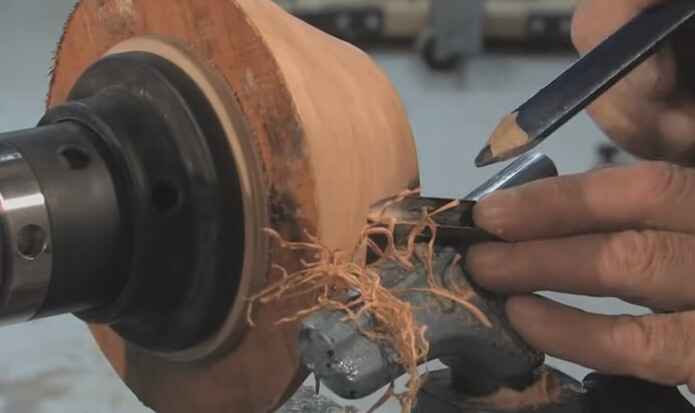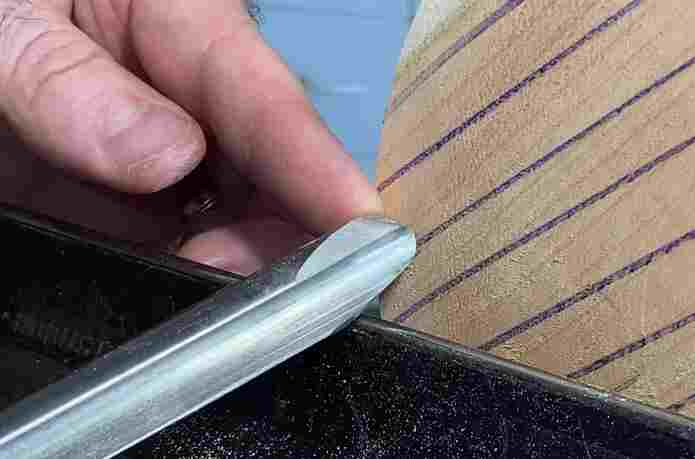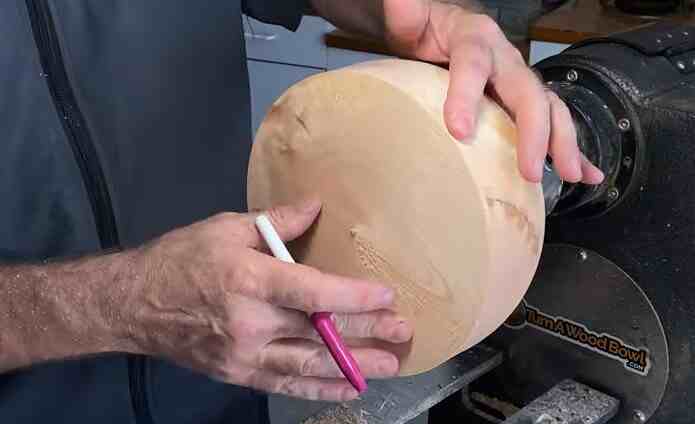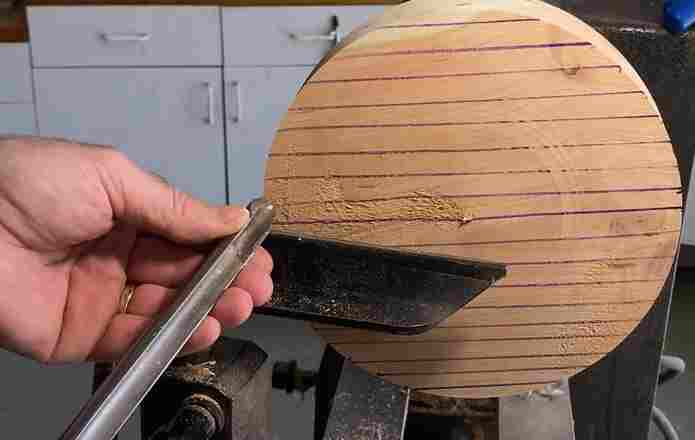Excessive pressure or improper tool rest height may cause a bowl gouge to catch. Ensure a light touch and correct tool rest positioning to prevent catches and achieve smooth turning.
Navigating the art of woodturning can be a thrilling journey, but for beginners, the occasional frustration of a bowl gouge catching can put a damper on the creative process. Fear not! In this guide, we'll unravel the mysteries behind why your bowl gouge keeps catching and provide practical solutions tailored for novices. Let's transform those challenges into opportunities for growth, ensuring a smoother ride on the exciting path of woodturning craftsmanship.


If you're a woodturner, you've had your fair share of catches while using a bowl gouge. Here, I'll explain the top five reasons why your bowl gouge is catching and how to avoid or fix the problem.
1. Incorrect bevel angle
An incorrect bevel angle is one of the most common reasons for a bowl gouge catch. The bevel angle is the angle of the cutting edge in relation to the rest of the tool. If the bevel angle is too shallow, the cutting edge will catch on the wood as it tries to cut. Conversely, if the bevel angle is too steep, the gouge will skate across the surface of the wood instead of cutting into it. The ideal bevel angle for a bowl gouge is between 35 and 45 degrees.
2. Dull cutting edge
Another common reason for catches is a dull cutting edge. As the cutting edge dulls, it becomes more difficult for the gouge to cut cleanly into the wood. This can cause it to catch on the wood and cause kickbacks or other accidents. To keep your bowl gouge sharp, you'll need to hone the cutting edge with a sharpening stone regularly.
3. Poor grip
Another common cause of catches is a poor grip on the tool. Not holding the bowl gouge correctly can slip in your hand and cause the cutting edge to catch on the wood. Make sure you're holding the gouge firmly with your thumb and first two fingers and that your fingers are wrapped around the shaft for added stability.
4. Incorrect grind
The grind on a bowl gouge is important for safety and performance. The cutting edge will likely catch on the wood if the grind is too shallow. Conversely, if the grind is too deep, the gouge will be more likely to grab and cause kickbacks. Most bowl gouges come with a factory grind suitable for general purpose turning, but you may need to adjust the grind to suit your specific needs.
5. Worn-out tool
Finally, it's important to note that even the best-made bowl gouge will eventually wear out and need to be replaced. Over time, the cutting edge will become dull, and the shaft will become bent or damaged. When this happens, it's time to retire the tool and get a new one.
Keeping these five factors in mind can help avoid catches while using your bowl gouge. If you experience a catch, prevent accidents by using proper safety equipment and techniques.
Related: You might find it useful to read about using a fingernail bowl gouge
What can I do to prevent my bowl gouge from catching?

1. Keep your bowl gouge sharp
One of the main reasons that bowl gouges catch is because they are not sharp enough. When the cutting edge is dull, it causes the tool to "grab" rather than slice through the material. This can be a major problem when turning bowls because the speed of the lathe makes it difficult to control a dull tool.
To avoid this, keep your bowl gouge sharpened and honed before each use. If you have to sharpen more frequently than usual, it may be time to invest in a better quality bowl gouge.
2. Use the proper technique
Another common reason for catching is improper technique. For example, when using a bowl gouge, you should always approach the workpiece from the outside edge and cut towards the center. This will help to prevent the tool from "digging in" and catching.
In addition, be sure to keep the tool angled correctly. The cutting edge should be at about 30 degrees to the workpiece. If the angle is too shallow, the tool will slip out of the cut; if it's too steep, it will dig in and catch.
3. Use a light touch
Another critical factor in preventing catches is the pressure you apply to the bowl gouge. When starting a cut, it's best to use a light touch and increase the pressure only as needed.
If you have to apply a lot of pressure to make the gouge cut, the cutting edge is likely not sharp enough. As mentioned above, a sharp tool will require less pressure and is less likely to catch.
4. Take shallow cuts
Taking shallow cuts is another good way to reduce the risk of catching. When making deeper cuts, there is more of a chance that the bowl gouge will "dig in" and grab the workpiece.
If you need to make a deep cut, it's best to do it in multiple passes rather than trying to take one big cut. This will help to keep the tool under control and prevent it from catching.
5. Reduce vibration
Another common cause of catches is vibration. When the bowl gouge vibrates, it can cause the cutting edge to "grab" rather than slice through the material. This is usually due to a dull cutting edge or incorrect technique.
To reduce vibration, be sure to sharpen the tool before each use and use the proper technique (as described above). In addition, you can try using a dampening agent such as WD-40 or vaseline on the cutting edge. This will help to absorb some of the vibrations and make it easier to control the tool.
6. Use a steadying hand
When using a bowl gouge, it's important to have a steadying hand. This will help to keep the tool under control and prevent it from catching.
If you find your hand shaking or trembling, it's best to take a break and try again when feeling more relaxed. It may also help to use a smaller tool for finer cuts.
7. Avoid high speeds
Another common cause of catches is turning the lathe too fast. When the lathe is set to a high speed, it can be difficult to control the bowl gouge. This can cause the tool to "grab" rather than slice through the material.
To avoid this, turning the lathe down to a lower speed is best before using the bowl gouge. This will help to keep the tool under control and prevent it from catching.
8. Use a jig
If you have difficulty preventing the bowl gouge from catching, you may consider using a jig. This device helps to guide the tool and keep it from wandering off course.
There are many different types of jigs available, so be sure to choose one that is appropriate for the size and shape of your workpiece. Using a jig can help to make the turning process easier and can also help to prevent catches.
Get the answers to bowl gouge keeps catching: Why it happens and how to fix it in the video below:
How can I fix a bowl gouge that has already been caught?

If you're a woodturning enthusiast, you know there's nothing more frustrating than having your bowl gouge catch. Not only does it ruin your piece, but it can also damage your tool. So, what can you do if you've already caught your bowl gouge?
Here are eight solutions:
If you're a woodturner, you know that bowl gouges can be tricky to work with. They tend to catch, which can be very difficult to fix when they do. Here I'll show you eight ways to fix a bowl gouge that has already been caught.
- The first thing you'll need to do is remove the tool from the lathe. Be careful when doing this, as you don't want to damage the tool or the lathe.
- Once the tool is removed, inspect it carefully. If there is any damage to the tool, you'll need to replace it.
- Next, you'll need to clean the tool. Use a brush or cloth to remove any debris from the tool.
- Once the tool is clean, you'll need to sharpen it. Use a sharpening stone or diamond file to sharpen the tool's cutting edge.
- Once the tool is sharp, you'll need to adjust the bevel angle. Use a protractor or angle finder to determine the correct bevel angle for the tool.
- Next, you'll need to set the tool in the lathe. Be sure to follow the manufacturer's instructions when doing this.
- You'll need to start the lathe and turn the tool. Be sure to go slowly at first and increase the speed gradually.
- If the tool catches again, repeat steps 1-7 until it no longer catches.
By following these steps, you should be able to fix a bowl gouge that has already been caught. Always take your time and be careful when working with woodturning tools.
Final Words
There are many ways to deal with a bowl gouge, but prevention may be best. If you're using a bowl gouge that keeps catching, it might be time to switch to a different tool or adjust your technique. However, with some practice, you can avoid this issue and keep turning those beautiful bowls!